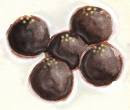::::::::::::::::::::::::::::::::::::::::::::::::::::::::::::::::::::::::::::::::::::::::::::::::::::
"Lily seed" Ubatama
***** Location: Japan
***** Season: All Summer
***** Category: Humanity
*****************************
Explanation
Before appreciating the sweet, we must study the plant in its honor.


hioogi 射干 (ひおうぎ) leopard flower
hioogi 檜扇(ひおうぎ)ヒオウギ
karasu oogi 烏扇(からすおうぎ) "fan for the crows"
Belamcanda chinensis , Leopardenblume
kigo for late summer
Blackberry lily, Leopard flower, Leopard lily
The leopard lily is a flowering perennial of Chinese origin and is locally used in Chinese villages for its medicinal values.
© More in the WIKIPEDIA !
:::::::::::::::::::::::::::::::::::::::::::::::::::::::::::::::::::::::::::::::::::::::::::::::::::
quote
Do you know the leopard flower?
It is also called black spotted iris, and it is called “Hioughi” in Japanese. In late summer this plant bears orange flowers, 4 to 5 cm across, whose eye-catching spots explain its English name.
 The shape of its leaves looks like that of “Hioughi,” hand-held fan of Heian period. These were folding wooden fans held by court ladies or aristocrats of the Heian period when formally dressed.
The shape of its leaves looks like that of “Hioughi,” hand-held fan of Heian period. These were folding wooden fans held by court ladies or aristocrats of the Heian period when formally dressed.That is the reason why they have their Japanese name.
Actually, leopard flower and its leaves are not so famous even for Japanese people.
But its seeds are a bit more famous as a pronoun of real black color in ancient Japanese, called as “Nubatama ぬばたま【射干玉】” color. (ubatama, mubatama 鳥羽玉 うばたま, 老玉。むばたま)
In ancient Japanese language, “Nuba” means black, and in fact this is the oldest expression of black color in recorded Japanese language. A ball is called “Tama,” so Nubatama means a black ball in ancient Japanese.
After flowering of leopard flower, a pale-green pod grows up keeping the young berries inside, and as they mature it peels back to reveal a cluster of ripe real black fruits Nubatama.
When ancient Japanese Waka poets described the blackness of a night, or a woman's voluptuous hair, they used this black berries as a beautiful image and put “Nubatama” as a introduction of those night blackness or hair blackness.
This is an example of Waka poem translated :
Black berry like black nights
will absorb my black hairs
into their black world,
and my heart will fly through it
to my lover’s bed.

Black sugar flavored red bean paste is wrapped by thin agar-jelly.
Red bean paste is sometimes too sweet for Western people to eat through. Since you have to do a lot of effort to remove the bitterness of red bean, some bad sweet makers try to put a lot of sugar into the red bean paste in order to mask the bitterness by strong sweetness.
source : kyotosweetgourmet.blogspot.com
:::::::::::::::::::::::::::::::::::::::::::::::::::::::::::::::::::::::::::::::::::::::::::::::::::::
Since Showa 17 this is a famous sweet of Kyoto. Four balls make one serving.
It is made by Kameya Yoshinaga Confectionery 亀屋良則.
There are other ubatama sweet ball producers in Kyoto
仙太郎の老玉 from Sentaro
. . . CLICK here for Photos !
仙若堂のうば玉 from Senjakudo
三河屋のうば玉 from Mikawaya

. . . CLICK here for Photos !
*****************************
Worldwide use
*****************************
Things found on the way
居明かして君をば待たむぬばたまの
我が黒髪に霜は降るとも
ii-akashite kimi oba matamu nubatama no
waga kurokami ni shimo wa furedomo
until dawn
I will wait for you
and not sleep
even if the frost
covers my pitch-black hair
Iwano Hime no Ookisaki 磐姫皇后
5. Century Emperess, wife of Jintoku Tenno 仁徳天皇
*****************************
HAIKU and SENRYU
実檜扇 待たせつれない人もいた
mi hioogi matasetsurenai hito mo ita
leopard lily seeds -
and there are also people
who are not kept waiting
Hidamari ひだまり
http://shashin-haiku.jp/node/40789
With respect to the waka quoted above.
*****************************
Related words
***** WAGASHI ... Sweets SAIJIKI
:::::::::::::::::::::::::::::::::::::::::::::::::::::::::::::::::::::::::::::::::::::::::::::::::::




No comments:
Post a Comment